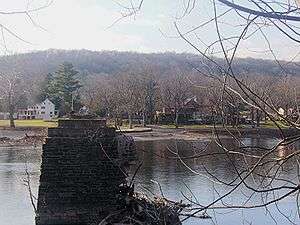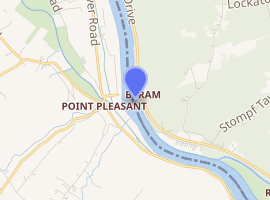Point Pleasant–Byram Bridge
The Point Pleasant–Byram Bridge was a bridge across the Delaware River between Point Pleasant, Bucks County, Pennsylvania and the Byram section of Kingwood, Hunterdon County, New Jersey. The bridge was a four-span, steel structure that was built in 1903 after several previous predecessor bridges (built in 1855 as a wooden covered bridge[1] and in 1892 as a first steel structure[2]) were wiped away by weather-related incidents. Funded by a private company, the bridge was tolled until February 13, 1919 when the Delaware River Joint Toll Bridge Commission paid the owners for the bridge.[4] One of the most modern on the river, the bridge was the first bought in Hunterdon County, New Jersey. Flooding from Hurricane Connie and Hurricane Diane in 1955 wiped away the bridge once again, along with three others along the river. Unlike the Yardley–Wilburtha and Portland–Columbia Pedestrian Bridge, the Point Pleasant–Byram Bridge was never replaced and the piers remain in the Delaware River.[5]
Point Pleasant–Byram Bridge | |
|---|---|
 Point Pleasant–Byram Bridge pier in November 2008 | |
| Coordinates | |
| Crosses | Delaware River |
| Locale | Point Pleasant, Bucks County, Pennsylvania and Byram, Hunterdon County, New Jersey |
| Characteristics | |
| Design | Truss bridge |
| History | |
| Opened | 1855[1] |
| Rebuilt | 1892[2] 1903[3] |
| Closed | August 20, 1955 |

| |
Bibliography
- Dale, Frank Talbot (2003). Bridges Over the Delaware River: A History of Crossings. New Brunswick, New Jersey: Rutgers University Press. ISBN 0813532132.CS1 maint: ref=harv (link)
References
- Dale 2003, p. 52.
- Dale 2003, p. 53.
- Dale 2003, p. 53–54.
- "States Buy Bridge". The Tribune. Scranton, Pennsylvania. February 14, 1919. p. 11. Retrieved November 10, 2019 – via Newspapers.com.

- Dale 2003, p. 54–55.